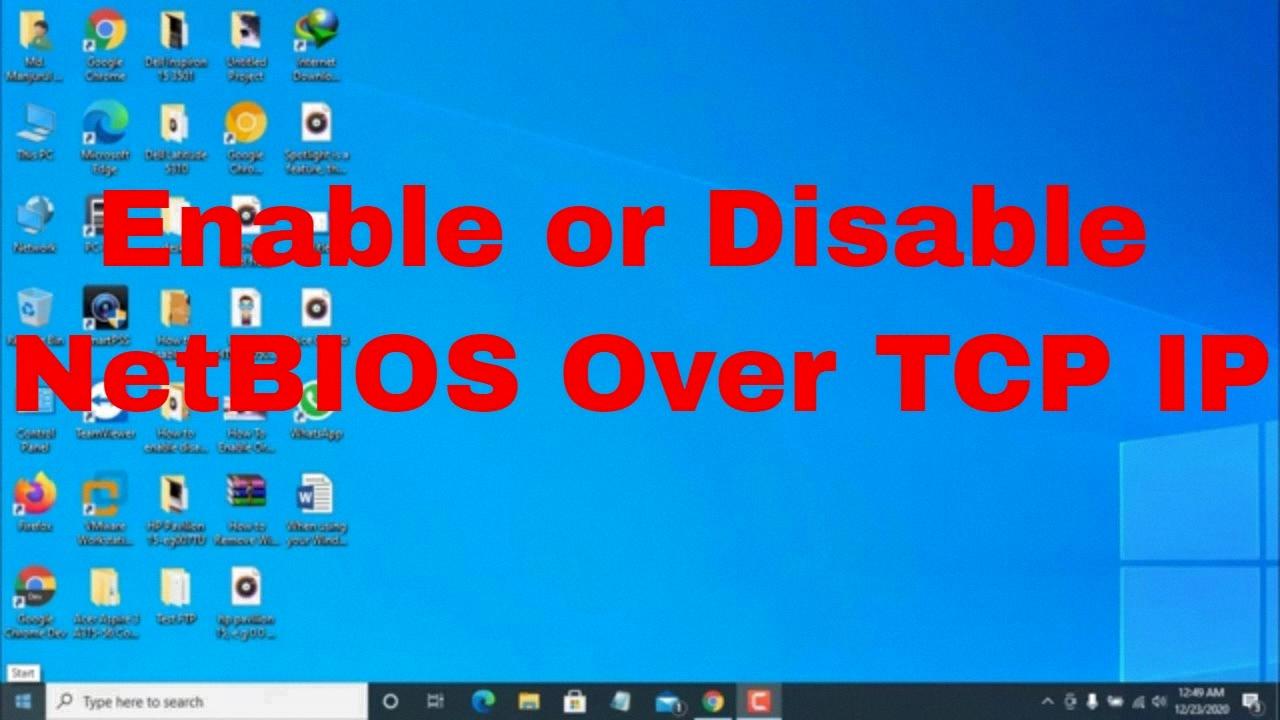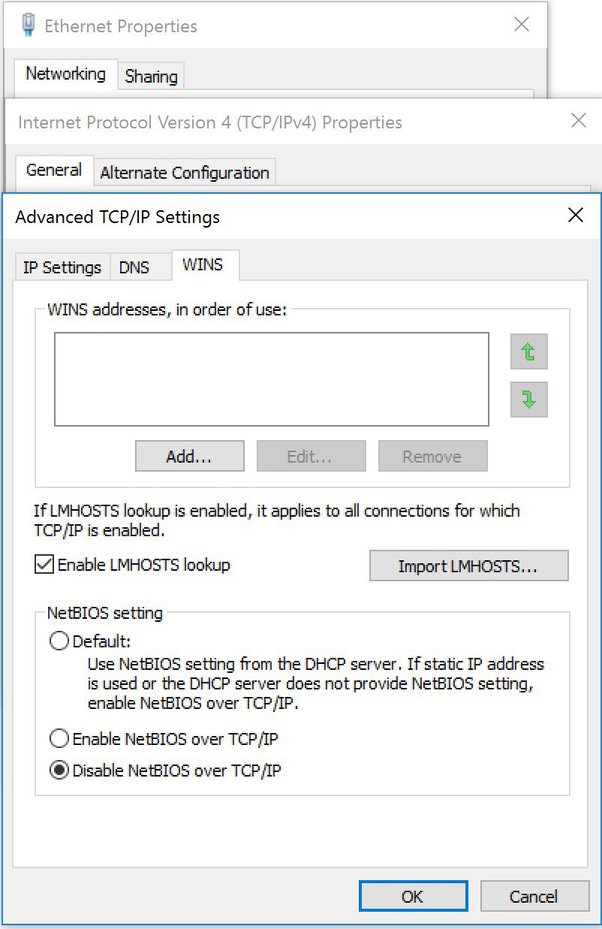NetBIOS over TCP/IP is a programming interface that extends the reach of NetBIOS client and server programs to the wide area network (WAN). It provides interoperability with various other operating systems and is not required for standard Windows networking function. However, it is recommended to disable NetBIOS over TCP/IP to improve network performance, especially on Hyper-V and Windows Server cluster hosts with dedicated NICs used for traffic, such as iSCSI and Live Migration.
Disabling the use and support of NetBIOS can help to mitigate an attacker’s ability to poison and spoof responses, obtain a user’s hashed credentials, inspect web traffic, and more. NetBIOS itself is an API, not a networking protocol. NetBIOS over TCP/IP provides the NetBIOS programming interface over the TCP/IP protocol.
Disabling NetBIOS over TCP/IP is easy and can be done in a few steps. First, open the Control Panel and go to Network and Sharing Center. Click on Change adapter settings and select the network adapter you want to modify. Right-click on it and select Properties. Scroll down to Internet Protocol Version 4 (TCP/IPv4) and click on Properties. Click on Advanced and go to the WINS tab. Under NetBIOS setting, select Disable NetBIOS over TCP/IP and click OK.
It’s important to note that disabling NetBIOS over TCP/IP may cause issues with legacy applications that require the API to function. If you experience problems with your apps, you may need to re-enable it. However, leaving it enabled will not harm your network in any way.
Disabling NetBIOS over TCP/IP can improve network security and performance, especially on dedicated NICs used for traffic. However, it may cause issues with legacy applications and should be re-enabled if necessary. As with any network configuration change, it’s important to test and monitor the impact of disabling NetBIOS over TCP/IP befre implementing it in a production environment.
Disabling NetBIOS Over TCP/IP
Disabling NetBIOS over TCP/IP can have a significant impact on network performance, especially in scenarios where there are dedicated NICs used for specific types of traffic, such as iSCSI and Live Migration. NetBIOS is an outdated protocol that was used in the past for name resolution and file sharing on local area networks (LANs). However, it is not necessary for modern networks, and disabling it can help to reduce unnecessary network traffic and improve overall performance.
When NetBIOS over TCP/IP is enabled, it can generate a lot of broadcast traffic on the network, which can cause congestion and slow down other network traffic. Disabling NetBIOS over TCP/IP can help to reduce this broadcast traffic and free up network bandwidth for other applications and services. It can also help to improve security by reducing the attack surface of the network.
If you have dedicated NICs for specific types of traffic, such as iSCSI and Live Migration, disabling NetBIOS over TCP/IP on tose NICs can help to reduce unnecessary traffic and improve performance. It is important to note that disabling NetBIOS over TCP/IP may cause some legacy applications that rely on it to stop working properly. However, most modern applications and services do not require NetBIOS over TCP/IP and should work just fine with it disabled.
To disable NetBIOS over TCP/IP, you can go to the properties of your network adapter and uncheck the box for “NetBIOS over TCP/IP” in the TCP/IP properties. Alternatively, you can use group policy settings to disable NetBIOS over TCP/IP across multiple computers in your network.

Source: youtube.com
Impact of Disabling NetBIOS
Disabling NetBIOS has several effects on a network. NetBIOS (Network Basic Input/Output System) is an API that allos applications on different computers to communicate within a local network. It operates on port 137 (UDP) and ports 139 and 445 (TCP).
If NetBIOS is disabled, the following effects may be observed:
1. Reduced network traffic: Since NetBIOS is not used, there is less network traffic, which can help increase network performance.
2. Improved security: Disabling NetBIOS can help to mitigate several security risks. For example, it limits an attacker’s ability to poison and spoof responses, obtain a user’s hashed credentials, and inspect web traffic. This is because many attacks leverage NetBIOS to gain access to a network.
3. Incompatibility with older applications: Some older applications may rely on NetBIOS for communication. If NetBIOS is disabled, these applications may not work correctly.
4. Issues with file and printer sharing: NetBIOS is used for file and printer sharing on a network. If it is disabled, file and printer sharing may not work correctly.
5. Difficulty in browsing network resources: NetBIOS provides a way to browse network resources such as shared folders and printers. If it is disabled, it may be more difficult to browse these resources.
To disable NetBIOS, you can do so on a per-interface basis or globally for all interfaces. This can typically be done in the network adapter settings or through Group Policy. It’s important to note that disabling NetBIOS may not be appropriate for all environments and should be done with caution.
The Function of NetBIOS Over TCP/IP
NetBIOS over TCP/IP (Transmission Control Protocol/Internet Protocol) is a protocol that enables NetBIOS (Network Basic Input/Output System) programming interface to work over TCP/IP networks. NetBIOS over TCP/IP provides an extension to the traditional NetBIOS protocol, which operates over LAN (Local Area Network) technologies like NetBEUI (NetBIOS Extended User Interface) and IPX/SPX (Internet Packet Exchange/Sequenced Packet Exchange).
NetBIOS over TCP/IP provides several benefits. First, it extends the reach of NetBIOS client and server programs to the WAN (Wide Area Network), which enables geographically distributed clients and servers to communicate with each other. Second, it provides interoperability with various other operating systems, including Unix, Linux, and Mac OS X, which do not support traditional NetBIOS protocols.
NetBIOS over TCP/IP operates over port 139 and 445, which are reserved for NetBIOS communication. When a NetBIOS client sends a request to a NetBIOS server over TCP/IP, the request is encapsulated in a TCP/IP packet and sent over the network. The server receives the request, extracts the original NetBIOS request, processes it, and sends a response back to the client.
NetBIOS over TCP/IP uses several services, including the Name Service, Session Service, and Datagram Service. The Name Service is responsible for name registration and resolution, which enables clients to locate servers by name. The Session Service establishes and maintains a connection between the client and server, which enables data to be exchanged between them. The Datagram Service enables clients to send messages to servers wihout establishing a connection.
NetBIOS over TCP/IP is a protocol that extends the reach of NetBIOS client and server programs to the WAN and provides interoperability with various other operating systems. It uses several services, including the Name Service, Session Service, and Datagram Service, to enable clients and servers to communicate with each other over TCP/IP networks.
Do I Need to Enable NetBIOS Over Tcpip?
NetBIOS over TCP/IP (NetBT) is a legacy protocol that was introduced by Microsoft many years ago. It provides a way for applications to communicate with each oher over a network. However, it is not required for standard Windows networking function.
If you are using modern applications and protocols like DNS and Active Directory, you do not need to have NetBIOS over TCP/IP enabled. These newer technologies are more secure and efficient than NetBT.
However, if you are using legacy applications that depend on NetBIOS over TCP/IP to function, you will need to keep it enabled. Disabling it could cause these applications to stop working.
It is important to note that there are security implications of keeping NetBIOS over TCP/IP enabled. It exposes your system to potential attacks, as it is an older protocol that was not designed with modern security threats in mind.
Therefore, it is recommended that you disable NetBIOS over TCP/IP if you do not need it for legacy applications. This can be done in the network settings of your Windows computer.
NetBIOS over TCP/IP is not required for modern Windows networking, but may be necessary for legacy applications. Disabling it can improve security, but may cause issues with certain programs.

Conclusion
NetBIOS over TCP/IP is a legacy API that provides the NetBIOS programming interface over the TCP/IP protocol, allowing NetBIOS client and server programs to function over a wide area network and providing interoperability with oher operating systems. However, it is not required for standard Windows networking function and can pose security risks, such as the ability for attackers to poison and spoof responses, obtain hashed credentials, and inspect web traffic. Therefore, it is recommended to disable NetBIOS over TCP/IP to improve network performance and mitigate these risks. However, if you have legacy applications that require the API to function, you may need to re-enable it. Ultimately, the decision to enable or disable NetBIOS over TCP/IP should be based on your specific needs and security concerns.
